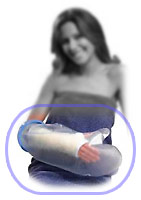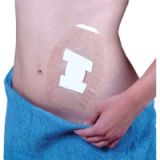For many people, minor scrapes and bruises are only a nuisance. It is easy to clean a wound, apply an antimicrobial ointment, and stick on a bandage.
However, if the wounds are bigger, they require more effort to keep clean and this is where bandage protectors and waterproof dressings are important. For people who live active lifestyles or are exposed to a moist environment, these are important items that help to ensure a safe and speedy recovery.
A bandaged or covered wound exposed to moisture can potentially create an excellent breeding ground for bacteria. A bandage provides a warm, porous environment for bacterial growth. As a wound seeps, blood or pus can provide nutrition for bacteria in a band aid, creating the potential for a dangerous infection. A bacterial infection in a wound can lead to gangrene, septicemia, and many other sever illnesses. By keeping a wound dry with waterproof bandage protectors, bacteria cannot proliferate as easily.

 Waterproof Dressings
Waterproof Dressings
A great way to keep a wound dry is by using waterproof dressings. These usually go over a wound or other bandage, and help keep outside moisture from entering a wound. Many of these dressings are breathable, allowing natural moisture and sweat to evaporate. These band aids will stay on even if you are sweating.
- Extra Thin Waterproof Dressings – These 4 inch by 4 inch waterproof dressings are for small wounds. Feels like fake skin and is perfect for external ulcers or skin lesions. Helps your wounds heal faster.
- Transparent Wound Dressings – Has a waterproof barrier that also blocks bacteria out. Be able to see the progress of your wound through the dressing. Stays on even when you are sweating, showering or swimming.
Air Tight Cast Protectors
 For athletes and other physically active individuals, a broken arm or leg can be a challenging experience. By using cast bandage protectors, athletes can engage in the activities they enjoy, while still allowing for safe healing. It’s important to keep a cast dry, as water exposure can degrade the cast and create an environment for bacteria to grow. For people with a broken arm or leg, regular exercise is essential to maintain muscle tissue during recovery. Many doctors and physical therapists recommend aquatic physical therapy to aid recovery. Air tight cast protectors can also enable individuals to swim, scuba dive, and enjoy other aquatic activities while recovering from a broken limb.
For athletes and other physically active individuals, a broken arm or leg can be a challenging experience. By using cast bandage protectors, athletes can engage in the activities they enjoy, while still allowing for safe healing. It’s important to keep a cast dry, as water exposure can degrade the cast and create an environment for bacteria to grow. For people with a broken arm or leg, regular exercise is essential to maintain muscle tissue during recovery. Many doctors and physical therapists recommend aquatic physical therapy to aid recovery. Air tight cast protectors can also enable individuals to swim, scuba dive, and enjoy other aquatic activities while recovering from a broken limb.
By using waterproof dressings or a cast protector on a wound, it’s possible to ensure a safe and healthy recovery, free from the risk of bacterial infection.
